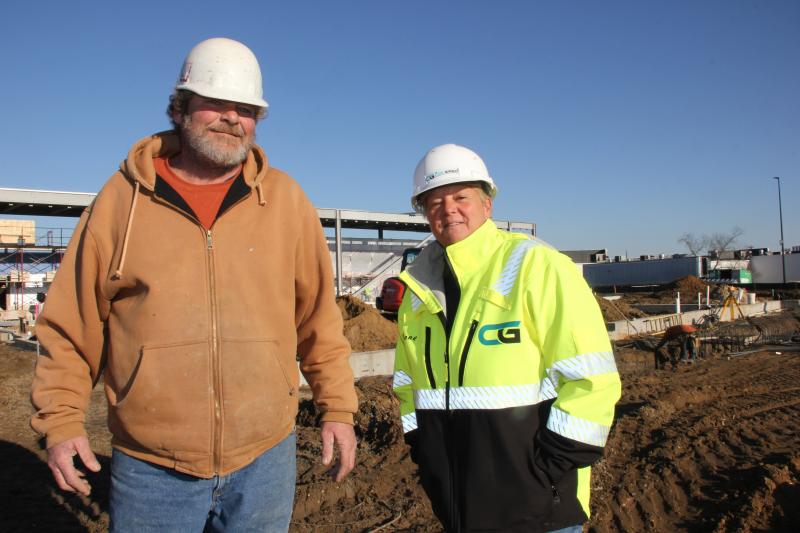New Lewes Transit Center more than just a parking lot
We’re in the thick of winter now. Days are cooler and shorter. When rain comes, mud on construction sites stays sticky much longer than in the warmer months when sun and heat dry sites more quickly.
A great example of this is DelDOT’s new Lewes Transit Center taking shape just south of Five Points on Route 1. This week, contractors are deep in the mud doing extensive foundation work for the final and largest of three buildings. The work is slow and steady: digging dirt, carefully placing reinforcing steel known as rebar, pouring concrete, checking measurements and checking them again.
“We’ve been working through the rain, day by day,” said Anne Jacobi, owner and operator of the Cobi Group which won the DelDOT bid for construction of the facility. “I’m very pleased with the progress so far.”
At $9.5 million, the estimated year-long project is big. It includes a visitor center at the front of the property where buses will pick up and discharge passengers, and a large parking lot. At the back of the property are two buildings. The southernmost and most technical of the two buildings is where buses in DelDOT’s DART system will be maintained mechanically and kept clean for the growing ridership in Delaware’s coastal city.
The lift pits in the bus maintenance facilities and the bus-washing troughs involve a lot of specialized and technical construction work which partially accounts for the high price tag of the facility. Jacobi said wages paid to the subcontractors she works with are dictated by federal and state prevailing wage provisions. That also adds to the expense of this and most state projects. She said those prevailing wages add about 50 percent to labor costs when compared to usual wages paid in Sussex. Plus, she said, there’s the cost of building materials: “Every day they go up.”
Delaware is one of 28 states in the U.S. that annually sets prevailing wage rates for state and federally funded projects. According to an article on the internet: Prevailing Wage is defined as the hourly wage, usual benefits and overtime, paid in the largest city in each jurisdiction, to the majority of workers, laborers, and mechanics. Prevailing wages are established for each trade and occupation employed in the performance of public work.
Jacobi is proud of being “chief cook and bottle washer” for a woman-owned and -operated company in Delaware doing projects of this scale. “We’re a 101-year-old company,” she said as she watched workers placing and tying curved sections of rebar rods into place for the area where the buses will ultimately be washed. “We’re not a construction business; we’re a construction family. I’ve worked with some of these people for 50 years. Corky, my cousin, and I have worked together for 40 years. I’ve been at this, legally, for 45 years, but I started working at job sites with my father when I was 8 years old. He was a master carpenter, and I became a carpenter too. He was an aggressive man, but he appreciated workers no matter their gender. We started out in Little Italy in Wilmington and grew from there.”
Jacobi moved to Rehoboth Beach eight years ago and is happy to be working at a job site just a few miles from her home. “I love it down here. Our main office is in Wilmington, but we also have an office here on Route 24.”
Depending on the day and the work being done, Jacobi said there are anywhere from 20 to 40 employees on the site every day. Lots of them are locals.
“I’m blessed to have very good subcontractors that we’ve worked with for years - some as many as 30 years,” she said. “I only bring in the best. I’m spoiled, working so long with these people. I have a lot of guys backing me. We all have to work together to keep our reputation up. I also have a great working relationship with Bill Thatcher of DART [Delaware Area Regional Transit]. We’re all working together to make this a great project. I think the people of Lewes and Rehoboth will be very proud of it.”
DelDOT and the Cobi Group expect this transit center to be serving Delaware’s coastal area for a long time to come. It’s being built that way.
Mike Bona, foreman for Cavan Concrete, lives in Fenwick Island and enjoys fishing when he’s not overseeing concrete work. He knows structure.
“There’s 60 tons of rebar in this project,” he said. “When the ocean rises and this is underwater, I’ll have the coordinates for this site. It will be great for tautog fishing.”
How much more vested in a project could you possibly be?

























































